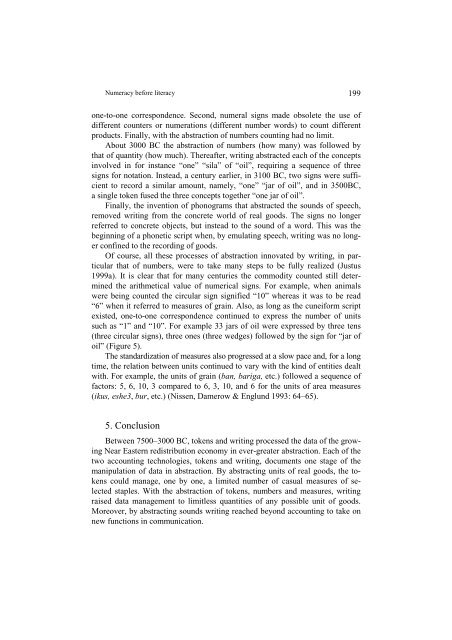s - Wyższa SzkoÅa Filologiczna we WrocÅawiu
s - Wyższa SzkoÅa Filologiczna we WrocÅawiu
s - Wyższa SzkoÅa Filologiczna we WrocÅawiu
Create successful ePaper yourself
Turn your PDF publications into a flip-book with our unique Google optimized e-Paper software.
Numeracy before literacy 199<br />
one-to-one correspondence. Second, numeral signs made obsolete the use of<br />
different counters or numerations (different number words) to count different<br />
products. Finally, with the abstraction of numbers counting had no limit.<br />
About 3000 BC the abstraction of numbers (how many) was follo<strong>we</strong>d by<br />
that of quantity (how much). Thereafter, writing abstracted each of the concepts<br />
involved in for instance “one” “sila” of “oil”, requiring a sequence of three<br />
signs for notation. Instead, a century earlier, in 3100 BC, two signs <strong>we</strong>re sufficient<br />
to record a similar amount, namely, “one” “jar of oil”, and in 3500BC,<br />
a single token fused the three concepts together “one jar of oil”.<br />
Finally, the invention of phonograms that abstracted the sounds of speech,<br />
removed writing from the concrete world of real goods. The signs no longer<br />
referred to concrete objects, but instead to the sound of a word. This was the<br />
beginning of a phonetic script when, by emulating speech, writing was no longer<br />
confined to the recording of goods.<br />
Of course, all these processes of abstraction innovated by writing, in particular<br />
that of numbers, <strong>we</strong>re to take many steps to be fully realized (Justus<br />
1999a). It is clear that for many centuries the commodity counted still determined<br />
the arithmetical value of numerical signs. For example, when animals<br />
<strong>we</strong>re being counted the circular sign signified “10” whereas it was to be read<br />
“6” when it referred to measures of grain. Also, as long as the cuneiform script<br />
existed, one-to-one correspondence continued to express the number of units<br />
such as “1” and “10”. For example 33 jars of oil <strong>we</strong>re expressed by three tens<br />
(three circular signs), three ones (three <strong>we</strong>dges) follo<strong>we</strong>d by the sign for “jar of<br />
oil” (Figure 5).<br />
The standardization of measures also progressed at a slow pace and, for a long<br />
time, the relation bet<strong>we</strong>en units continued to vary with the kind of entities dealt<br />
with. For example, the units of grain (ban, bariga, etc.) follo<strong>we</strong>d a sequence of<br />
factors: 5, 6, 10, 3 compared to 6, 3, 10, and 6 for the units of area measures<br />
(ikus, eshe3, bur, etc.) (Nissen, Damerow & Englund 1993: 64–65).<br />
5. Conclusion<br />
Bet<strong>we</strong>en 7500–3000 BC, tokens and writing processed the data of the growing<br />
Near Eastern redistribution economy in ever-greater abstraction. Each of the<br />
two accounting technologies, tokens and writing, documents one stage of the<br />
manipulation of data in abstraction. By abstracting units of real goods, the tokens<br />
could manage, one by one, a limited number of casual measures of selected<br />
staples. With the abstraction of tokens, numbers and measures, writing<br />
raised data management to limitless quantities of any possible unit of goods.<br />
Moreover, by abstracting sounds writing reached beyond accounting to take on<br />
new functions in communication.
















